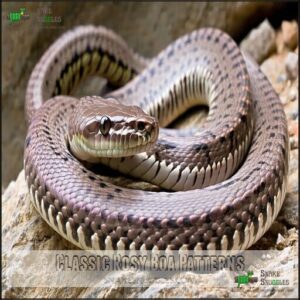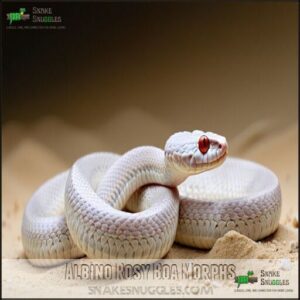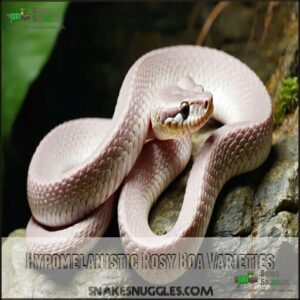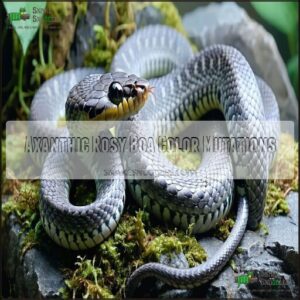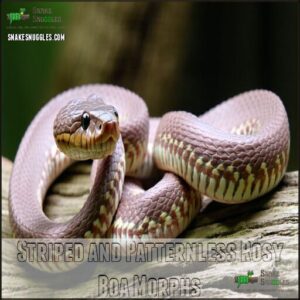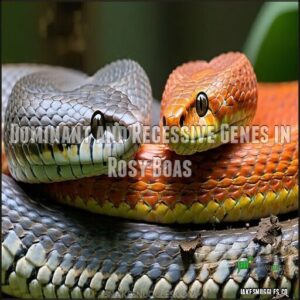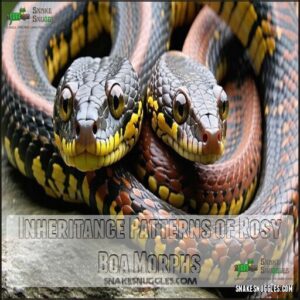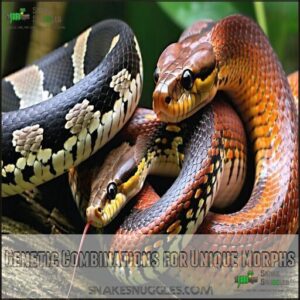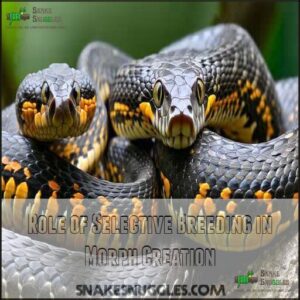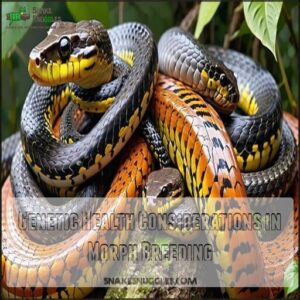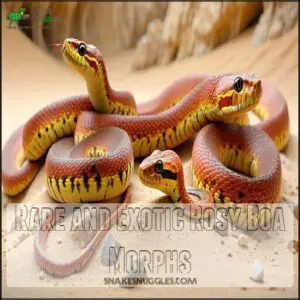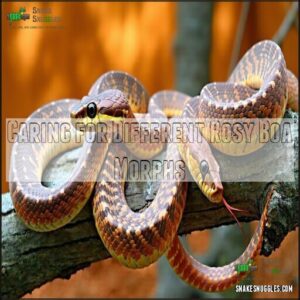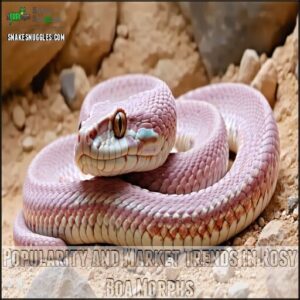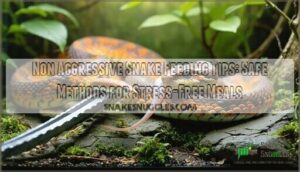This site is supported by our readers. We may earn a commission, at no cost to you, if you purchase through links.
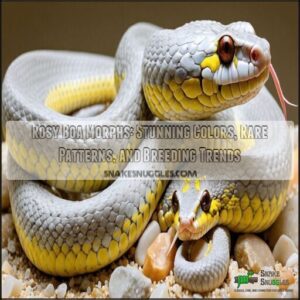 Rosy boa morphs are a stunning mix of genetics and artistry, offering a wide range of colors and patterns that make these snakes a herpetology favorite.
Rosy boa morphs are a stunning mix of genetics and artistry, offering a wide range of colors and patterns that make these snakes a herpetology favorite.
From the earthy tones of classic patterns to rare variations like albino, hypomelanistic, and axanthic morphs, each boa is uniquely beautiful.
Some feature crisp stripes, while others boast patternless looks or even mesmerizing color mutations.
These morphs result from specific genetic traits—dominant, recessive, or a combo—and careful selective breeding, which is a true reflection of dedicated work.
While they may look like nature’s own masterpieces, they reflect years of dedicated work, and rare or not, there’s always a story behind each scale!
Table Of Contents
- Key Takeaways
- Common Rosy Boa Morphs and Color Variations
- Genetics Behind Rosy Boa Morph Development
- Rare and Exotic Rosy Boa Morphs
- Caring for Different Rosy Boa Morphs
- Popularity and Market Trends in Rosy Boa Morphs
- Frequently Asked Questions (FAQs)
- What is a rosy boa color morph?
- What are the most common rosy boa morphs?
- What is a rosy boa?
- What does Anery rosy boa look like?
- How much does a rosy boa cost?
- How long does a rosy boa live?
- How many types of rosy boas are there?
- How to tell if rosy boa is gravid?
- Do rosy boas like being held?
- Can a rosy boa live in a 20 gallon tank?
- Conclusion
Key Takeaways
- You’ll find rosy boa morphs in diverse colors and patterns, like albino, hypomelanistic, and axanthic, each influenced by genetics and selective breeding.
- Breeding rosy boas requires understanding dominant and recessive traits, ensuring health through good genetic diversity and responsible practices.
- Albino and designer morphs, like Snow and Paradox Albino, are highly sought after, with prices ranging from $200 to over $50,000 based on rarity.
- Proper habitat care, like maintaining humidity and temperature gradients, keeps these snakes healthy and showcases their stunning patterns.
Common Rosy Boa Morphs and Color Variations
You’ll find Rosy Boas come in an incredible range of natural and selectively bred morphs, each showcasing distinct colors and patterns influenced by genetics and geography.
From subtle earthy tones to vibrant albino or striped variations, these boas offer endless possibilities for enthusiasts to appreciate. Endless possibilities for enthusiasts to appreciate.
Classic Rosy Boa Patterns
Exploring the classic patterns of rosy boa snake morphs feels like uncovering nature’s secrets. These snakes showcase unique stripe variations, blending into landscapes with their subtle yet mesmerizing designs. Each pattern tells a story of survival, shaped by nature and genetics.
- Color patterns range from soft earth tones to flashes of pink or deep maroon, highlighting habitat influences.
- Pattern aberrations include dotted or pixelated stripes, blending camouflage with natural beauty.
- Regional differences create locale-specific patterns, like desert-adapted browns or coastal variations.
- Scale anomalies reveal slight textural differences in pattern expression.
Every rosy boa is proof evolution’s an artist. Living among rocky deserts and coastal cliffs, these snakes embody elegance and adaptability, showing how survival and beauty intertwine effortlessly.
Albino Rosy Boa Morphs
The albino rosy boa stands out in the sphere of rosy boa morphs, showcasing stunning white scales and vibrant red eyes caused by albinism.
With melanin absent, they’re breathtaking but sensitive to sunlight, requiring shaded enclosures.
Albino genetics add excitement for breeders—pairing correctly gives a 50% chance of producing albino offspring.
These snake morphs capture attention just for their beauty but also for the breeding challenges they present, making them highly sought-after reptile morphs.
Hypomelanistic Rosy Boa Varieties
Hypomelanistic rosy boas, often called "hypo rosy boas," bring a whimsical spin to rosy boa morphs with reduced melanin creating softer, pastel-like hues.
These hypomelanistic snakes often appear as if they’ve been delicately painted with watercolors, offering beautiful pattern variations with lower contrast levels.
Here’s what makes them special:
- Reduced Melanin: Lighter coloring softens their overall appearance.
- Pattern Variations: Expect subtle tones ranging from creams to light browns.
- Breeding Outcomes: Both parents need the recessive hypomelanistic gene.
- Health Implications: Proper care emphasizes balanced lighting for skin health.
If you’re drawn to delicate hues, this morph blends beauty and fascinating genetics!
Axanthic Rosy Boa Color Mutations
Axanthic rosy boas are true showstoppers in the domain of color morphs, with their mesmerizing grayscale palette that plays effortlessly between silver, black, and subtle blue-gray tones.
They’re like the black-and-white photography of the snake world—timeless and elegant.
A grayscale wonder gliding through shadows, axanthic rosy boas embody timeless elegance with silver, black, and soft blue-gray hues.
These unique colors result from axanthism, a recessive genetic trait that eliminates yellow pigments, highlighting dark pigmentation and soft monochrome variations.
Breeding for Axanthic genetics takes patience, as both parents must carry the gene for this stunning morph to appear.
In captivity, experienced breeders often experiment by pairing Axanthics with other morphs, like hypomelanistic traits, to discover even more dramatic snake mutations.
As with other varieties, such as the popular Coastal rosy, proper terrarium setup is essential.
Whether you’re admiring their muted hues or intrigued by their genetic possibilities, Axanthic rosy boas offer beauty that’s both subtle and sophisticated, making them a favorite among collectors and enthusiasts.
Striped and Patternless Rosy Boa Morphs
Striped and patternless rosy boa morphs showcase nature’s creative genius. They’re a feast for the eyes and speak volumes about snake patterns and genetics.
- Stripe Variations: From bold, uninterrupted lines to aberrant patterns that ripple like water.
- Patternless Genetics: Imagine a glossy canvas of soft, unbroken hues—stunning yet understated.
- Reduced Striping: Clean, minimal designs that highlight precision breeding.
These color morphs are more than just reptiles—they’re living works of art, crafted through careful patternless breeding and careful observation of rosy boa morphs.
Genetics Behind Rosy Boa Morph Development
Understanding the genetics behind Rosy Boa morphs lets you see how traits like albinism or unique patterns are passed down through generations.
By exploring how dominant and recessive genes interact, you’ll uncover the secrets behind these appealing variations.
Dominant and Recessive Genes in Rosy Boas
Understanding how rosy boas pass on their colors and patterns isn’t just fascinating—it’s about cracking their genetic code.
Dominance hierarchy plays a big role in what you see. Dominant genes show up boldly, while recessive traits need both parents to pass them down.
Morph inheritance also depends on co-dominance, where traits can blend for unique patterns, and genetic mutations, which offer surprising twists.
For example, albinism and anerythrism are classic recessive traits uncovered through careful breeding.
It’s reptile genetics at its finest!
Inheritance Patterns of Rosy Boa Morphs
Traits in rosy boa morphs, like albinism, often follow predictable patterns but can still surprise breeders.
Snake genetics intertwine gene expression and recessive traits, where some qualities only surface when paired with identical genes. Polygenic inheritance adds complexity, involving multiple genes influencing a single trait.
One example is the popular Coastal rosy, known for variable patterns. Breeding rosy boas keeps you guessing, but it’s all part of the excitement.
- Recessive traits: Hidden until paired in offspring.
- Genetic variance: Adds unpredictability in outcomes.
- Mutation impact: Creates stunning, rare morphs.
Genetic Combinations for Unique Morphs
Creating unique rosy boa morphs is like being an artist with snake genetics. You’ll need a sharp eye for morph gene interactions and patience to master novel trait expression.
- Match recessive genes to uncover hidden patterns.
- Explore hybrid vigor by pairing diverse bloodlines.
- Combine mutations to spark polygenic inheritance magic.
Embrace the surprises genetic combinations bring—think wild stripes or epigenetic modifications releasing unexpected hues!
Role of Selective Breeding in Morph Creation
Selective breeding is a bit like crafting a masterpiece—great results take time, care, and precision.
Breeders rely on strategies like:
- Picking parents with standout traits.
- Pairing snakes to emphasize desired features.
- Studying generational patterns for trait fixation and avoiding genetic diversity loss.
- Following strict selective breeding ethics to guarantee morph health impacts are minimized.
This precise process helps create striking designer morphs while balancing challenges like potential genetic risks.
It’s a careful dance between creativity and responsibility in the sphere of morph creation.
Genetic Health Considerations in Morph Breeding
In the context of snake breeding, focusing on genetic health is like laying the groundwork for a solid house—it’s essential.
Breeding rosy boa morphs isn’t just about eye-catching patterns; it’s about genetic diversity and minimizing mutation risks.
Follow these tips:
- Maintain genetic diversity to avoid inbreeding depression.
- Screen breeding stock to identify lethal genes or abnormalities.
- Track genetic lines carefully to prevent unintended genetic deviation.
- Pair for hybrid vigor when possible, enhancing health.
- Document mutation effects to balance traits and vitality.
Strong genetics keep your rosy boas thriving for generations!
Rare and Exotic Rosy Boa Morphs
You’ll find some of the most fascinating Rosy Boas in the world among rare and exotic morphs, showcasing extraordinary colors and patterns that often arise from unique genetic traits.
These highly coveted snakes, from ultra-rare mutations to carefully designed combinations, offer a glimpse into both nature’s surprises and the artistry of selective breeding.
Ultra-rare Rosy Boa Color Mutations
Ultra-rare rosy boa mutations blend genetic magic and stunning rarity, turning snakes into breathtaking living treasures.
Ultra-rare rosy boa color mutations are the crown jewels of snake collecting, blending genetics and artistry into living masterpieces.
These rare snake morphs, often born from slim odds, captivate collectors worldwide.
- Moonglow Genetics: A stunning pearl-toned morph, it combines snow and hypomelanistic traits. With a 1/16 chance per breeding, its rarity adds to its allure.
- Matrix Albino: Introduced in 2014, this designer snake exhibits unique pixelated patterns unlike typical albinos.
- Hypo Mono-Stripe Albino: A one-of-a-kind rarity featuring a single bold stripe over an albino backdrop.
Untested mutations and lineage rarity continue to intrigue breeders, while morph collectability drives future discoveries. Each snake is more than its beauty—it’s evolution in action.
Locality-specific Rosy Boa Morphs
When you explore locality-specific Rosy Boa morphs, you’re uncovering nature’s artistry. Each region stamps its signature on these snakes, creating stunning adaptations.
Take Baja morphs, for instance—they reflect the vibrant hues of coastal landscapes. Desert locales, like Arizona and Southern California, produce Rosy Boas with pale tones and subtle patterns, blending them into arid terrains.
Coastal patterns stand out too, with pixelated or dotted stripes adding a unique flair.
Island morphs, like those from Baja’s Cedros Island, show striking characteristics influenced by isolation. Sonora variations showcase contrasting, bold stripes on lighter bodies.
Locality rosy boa morph identification reveals these natural morphs as evolutionary masterpieces, celebrating the profound ties between environment and appearance.
Designer Rosy Boa Morph Combinations
Combining creativity with science, designer rosy boa morphs are all about crafting dazzling new patterns and colors.
These snakes showcase traits like Snow morphs’ creamy silver tones or Picasso morphs’ outrageous pastel splashes.
Breeding designer morphs is part artistry, part precision. Moonglow genetics produce hypo, snow-like hybrids, while Hypocabazanthic morphs push boundaries with their bold contrasts.
Future combinations could reveal entirely unseen color morphs. Rosy boas are popular due to their docile temperament, making them ideal for breeders.
- Snowwhite hybrid vigor: Combines Axanthic and Albino genes, priced up to $1,250.
- Paradox Albino flair: Fluorescent with inky splashes, a true rarity.
- Matrix Albino demand: Vibrant yet modestly priced at $850.
Morph breeding guarantees every snake is a living canvas of stunning genetics.
Emerging and Newly Discovered Rosy Boa Morphs
In 2025, rosy boa morph discoveries continue to amaze breeders and enthusiasts alike.
Rare creations like Hypocabazanthic and Hypo Mono-Stripe Albino showcase groundbreaking genetic mutations.
These new morphs push the boundaries of morph development and breeding potential, spotlighting the artistry behind morph creations.
Each discovery holds promise for future exploration, conservation impact, and enriching the diversity of these already fascinating snakes.
Collector’s Value of Rare Rosy Boa Morphs
The collector’s market for rare rosy boa morphs thrives on the allure of morph desirability and rarity factors.
With rare morphs like the Paradox Albino Snow priced at a jaw-dropping $50,000, morph pricing highlights strong investment potential.
Key reasons rare morphs maintain high value:
- Limited availability enhances rarity and future value.
- Distinctive traits make rosy boa morphs irresistible to enthusiasts.
- Ethical concerns in breeding guarantee uniqueness and authenticity.
Breeders offer diverse options, including the Whitewater Albino rosy boas.
Caring for Different Rosy Boa Morphs
Caring for different Rosy Boa morphs means understanding their unique needs, from habitat adjustments to genetic health monitoring.
With consistent attention to their specific requirements, you’ll guarantee these stunning snakes stay vibrant and thrive in your care.
Specific Care Requirements for Albino Morphs
Albino rosy boas, with their striking appearance and delicate genetics, need extra TLC.
Due to albinism, their lack of melanin makes them highly sensitive to light and environmental changes. Keep their lighting sensitivity in mind by opting for low-wattage bulbs (40–60 watts). A proper temperature gradient is essential—maintain 75–85°F during the day, ensuring no sudden fluctuations.
For ideal setups, consider specialized lighting options for albino rosy boas.
For their dietary needs, feed smaller prey every 7–10 days to avoid stress on their digestion. Add plenty of enclosure decor, like hides and subdued spaces, to help them escape bright surroundings.
Habitat Adjustments for Various Color Morphs
A well-designed habitat keeps your rosy boa morphs healthy and vibrant.
Adjust their settings to mirror natural variations: desert environments work best for drier morphs with 30-40% humidity, while coastal morphs need 40-50%.
Substrates like aspen or sand simplify cleaning and enhance UV lighting effects. Consider boa morph substrate for ideal comfort.
Always maintain temperature gradients—85°F on the warm side, 70°F cooler—so they can regulate body heat. Add creative enrichment differences, like hides that match their color variations, giving them comfort and camouflage.
Feeding Considerations for Different Morphs
Feeding your rosy boa morphs doesn’t have to be complicated, but a few specialized tips can make all the difference. Proper meals help maintain their health and shine, whether they’re Albino, axanthic, or designer blends.
Here’s a quick guide to keep feeding smooth:
- Pick the right prey size – Match frozen rodents to the snake’s midsection width for easy swallowing.
- Stick to a schedule – Adults can eat every 10-14 days, while young snakes need meals every 7-10 days.
- Respect nocturnal feeding habits – Feed during evening hours for better responsiveness.
- Consider specific needs – Albino Diet adjustments may include dim light during feeding due to their light sensitivity.
Good feeding guidelines simplify the art of reptile care. Maintaining a dry, clean enclosure is key to preventing scale rot.
Health Monitoring in Specialized Rosy Boa Morphs
Keeping rosy boa morphs healthy means staying alert to morph-specific ailments and potential genetic predispositions.
Some morphs, like those with albinism, can have specific sensitivities impacting their husbandry.
Routine checks, including veterinary care, help catch issues early.
Using a proactive approach like this can give your boa a long, healthy life while keeping them stunning and stress-free!
Breeding Practices for Maintaining Morph Traits
While monitoring your specialized rosy boa’s health is essential, proper breeding practices ultimately determine whether prized traits persist through generations.
Successful rosy boa morph breeding hinges on balancing captive bred aesthetics with genetic vigor. When developing your breeding program:
- Implement rigorous lineage tracking systems—documenting parents, offspring traits, and genetic variance across multiple generations
- Prioritize genetic diversity by selecting unrelated specimens that share desired traits rather than breeding closely related individuals
- Refine incubation techniques specific to your morph varieties, as temperature fluctuations can impact hatchling vigor
Most experienced breeders rotate their breeding lines every 2-3 generations, preventing the "beautiful but fragile" syndrome that plagues many selectively bred morphs. Understanding boa morph products can aid in this process. This approach resembles a genetic dance—one step toward trait selection, two steps toward robust health, ensuring your rosy boa morphs remain both stunning and thriving.
Popularity and Market Trends in Rosy Boa Morphs
You’ll find the rosy boa morph market constantly evolving, with albino varieties commanding premium prices around $200 while locality-specific specimens attract dedicated collectors seeking genetic authenticity.
As hobbyist preferences shift between natural variations and designer morphs, you’re witnessing a fascinating intersection of conservation awareness and aesthetic appreciation that shapes breeding priorities across the herpetocultural community, reflecting a unique blend of genetic authenticity.
Most Sought-after Rosy Boa Morphs
Beyond basic care considerations, let’s examine which rosy boa morphs have reptile enthusiasts reaching for their wallets.
Among breeders and collectors, several morphs consistently command attention due to their striking appearance and genetic rarity.
Albino rosy boas remain perennial favorites with their vibrant orange stripes and distinctive red eyes. The snow rosy boa, combining albino and anerythristic traits, creates an eye-catching silvery-white appearance that collectors keenly pursue.
Hypomelanistic varieties show exceptional color contrast and rank high on collector wish lists. The ultra-rare Picasso morph, with its unique pastel-yellow and lilac patterning, represents the pinnacle of breeder influence and collector demand.
Mexican and coastal locality-specific specimens continue gaining popularity as enthusiasts appreciate their natural beauty and genetic integrity. The morph market constantly evolves as breeder innovations create new combinations that spark future morph development trends.
Price Ranges for Various Rosy Boa Morphs
Across the morph market, rosy boa morphs span a remarkable price spectrum shaped by rarity impact and breeding costs.
You’ll find entry-level varieties like Regular Rosy Boas at $130, while mid-range options such as Albino Whitewater morphs command around $350.
Market fluctuations affect pricing, with specialized variants like Picasso Rosy Boas fetching $1,500.
For serious collectors, investment potential peaks with the Paradox Albino PosHet Snow at an eye-watering $50,000.
Snake morph pricing reflects genetic complexity—heterozygous (Het) carriers typically cost less than visual morphs.
Morph affordability varies, making thoughtful morph selection essential whether you’re a casual enthusiast or dedicated breeder, considering the overall investment potential.
Emerging Trends in Rosy Boa Morph Popularity
Emerging rosy boa morphs keep enthusiasts buzzing with excitement. Price fluctuations are influenced by morph demand, rarity, and vibrant appearances.
Snake morph pricing reveals how scarce, high-contrast morphs attract collectors.
- Unique Colors: Bright, striking hues remain popular.
- Rarity Appeal: Scarce morphs dominate interest.
- Designer Morphs: Innovative breeding captivates buyers.
- Market Growth: Ethical breeding promotes conservation impact and global availability.
Impact of Morphs on Rosy Boa Conservation
Rosy boa morphs are stunning yet remind us that snake conservation hinges on habitat preservation and genetic diversity.
Supporting responsible breeding guarantees these intriguing natural morphs thrive without harming wild populations.
Here’s a quick look:
| Conservation Focus | Benefits | Importance |
|---|---|---|
| Habitat Preservation | Protects wild populations | Sustains ecosystems |
| Responsible Breeding | Promotes morph genetics | Avoids inbreeding, guarantees healthy snakes |
| Conservation Education | Builds awareness | Discourages illegal wildlife trade |
Future Predictions for Rosy Boa Morph Development
Snake breeding projects are shaping rosy boa morph evolution, and the future is exciting.
You’ll see morph genetics advancing through creativity and genetic engineering. Experts are balancing trait stabilization with demand trends while adopting ethical considerations for sustainability.
Here’s a glimpse of what’s ahead:
- Breakthrough new morphs with bright, unique patterns.
- Precision breeding to refine designer traits.
- Sophisticated tools predicting genetic outcomes.
- Rising global interest fueling morph opportunities.
- Collaborative reptile breeding projects, emphasizing conservation.
Frequently Asked Questions (FAQs)
What is a rosy boa color morph?
A color morph is a genetic variant that changes an animal’s appearance.
With rosy boas, these morphs create unique patterns and hues, from natural albino to selectively-bred Picasso.
Each tells its own colorful story.
What are the most common rosy boa morphs?
It’s fascinating how nature gets creative.
Common rosy boa morphs like albino, anerythristic, and snow stand out for their stunning patterns, from vivid orange creams to silvery whites.
Each morph celebrates genetic artistry and uniqueness.
What is a rosy boa?
You’ve got a friendly, small boa constrictor with shiny scales and distinct stripes here.
Native to the Southwestern U.S. and Baja California, it thrives in rocky habitats, staying non-venomous, calm, and easygoing.
What does Anery rosy boa look like?
They say beauty is in the eye of the beholder,
but you can’t miss an anery Rosy Boa’s creamy lavender or soft blue-gray tones, with strikingly dark brown stripes and a smooth, elegant finish.
How much does a rosy boa cost?
Rosy boa prices range from $80 to $200, depending on its morph, rarity, and origin.
Common morphs like Anery or albino sit at the lower end, while unique options, like Snow, demand higher prices.
How long does a rosy boa live?
Ever wonder how long a pet snake might stick around?
With proper care, a rosy boa can live over 15 years, sometimes exceeding 20!
That’s plenty of time to build a slithery friendship!
How many types of rosy boas are there?
You’ll find five main types of rosy boas, identified by locality-based subspecies: Mexican, Desert, Coastal, Rosada Del Noroeste, and Lichanura Trivirgata Myriolepis.
Each showcases unique patterns, colors, and geographic distinctions.
The rosy boas are distinguished by these locality-based subspecies.
How to tell if rosy boa is gravid?
If your rosy boa stops eating, appears unusually round or swollen near the midsection, and rests more in warm areas, she might be gravid.
Look for subtle movements too—tiny kicks can confirm pregnancy!
Do rosy boas like being held?
Like a gentle ribbon of life, your rosy boa tolerates handling if it’s calm and accustomed to you.
They don’t crave it but can remain relaxed with care—warm hands, slow movements, and patience foster trust.
Can a rosy boa live in a 20 gallon tank?
A 20-gallon tank works for a young rosy boa or a smaller adult, but for long-term comfort, aim for a 30-gallon enclosure.
They need room to explore, hide, and thermoregulate effectively.
Conclusion
Did you know there are over 20 recognized rosy boa morphs, with new ones emerging through selective breeding?
Each morph, from vibrant albinos to subtle axanthics, highlights the fascinating potential of genetics and careful husbandry.
Whether you’re drawn to bold stripes or patternless designs, rosy boa morphs offer endless variety for enthusiasts.
Understanding their care, genetics, and trends guarantees both their beauty and well-being endure.
Explore, learn, and appreciate the artistry behind these living masterpieces!

